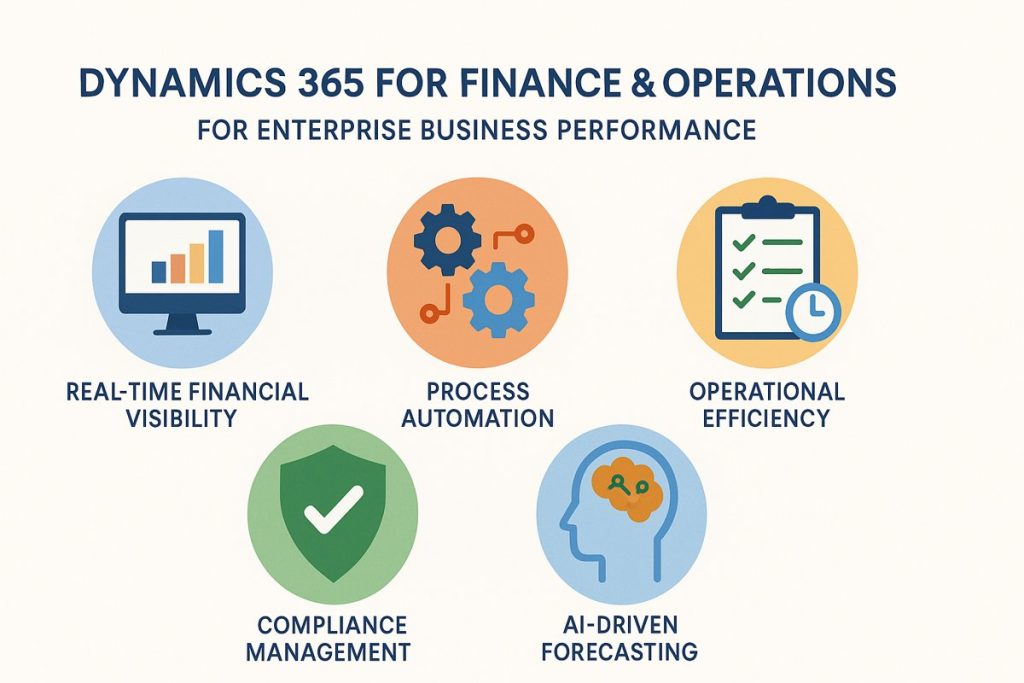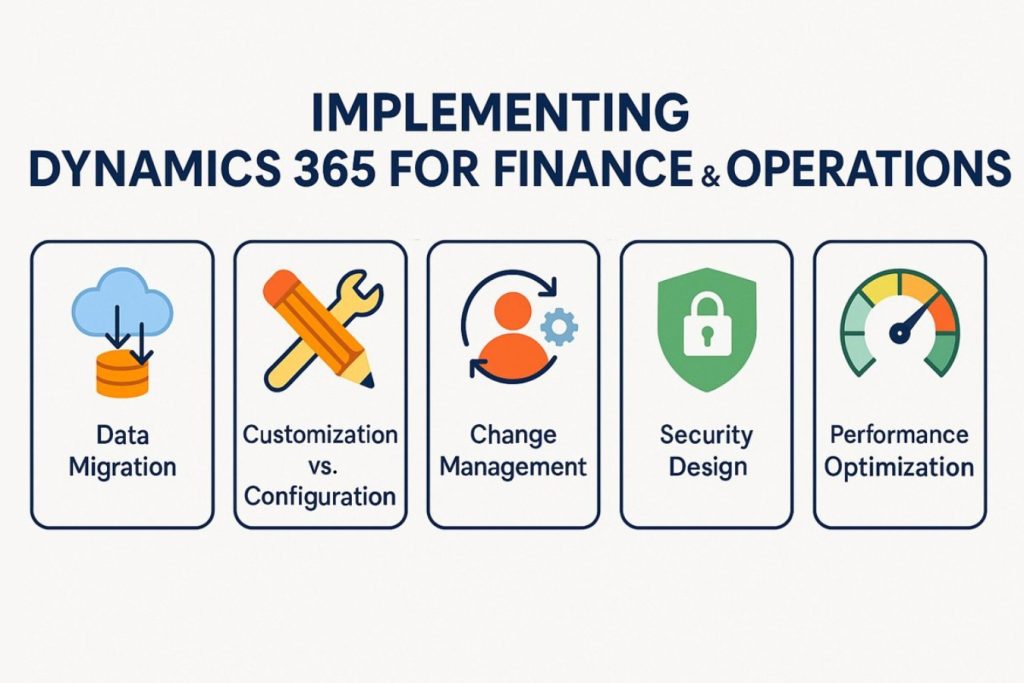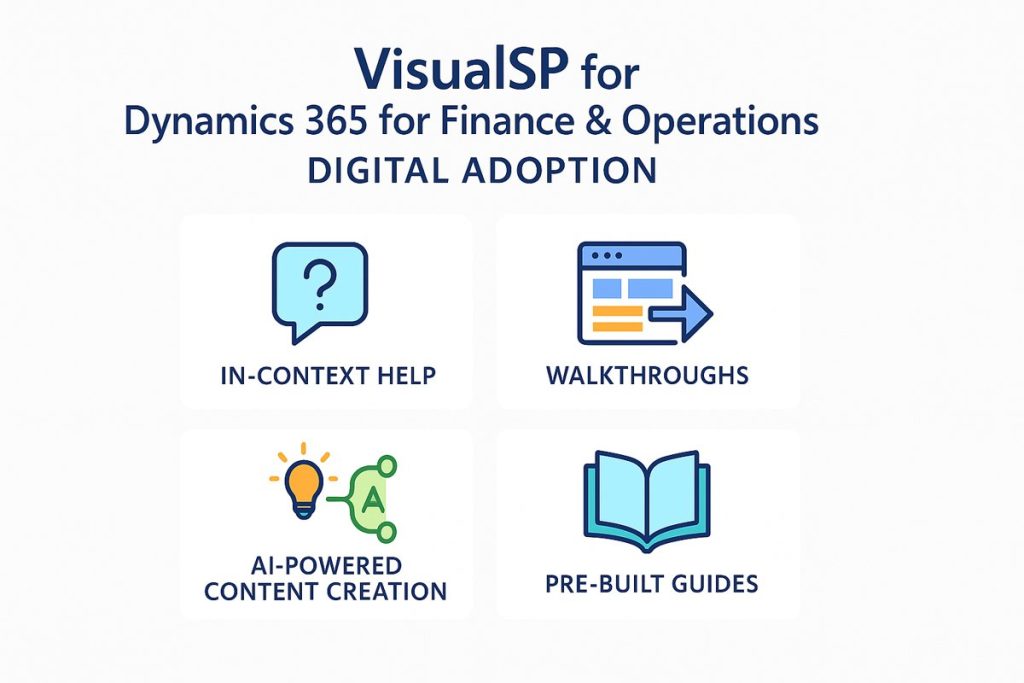
In my experience advising enterprises through complex ERP transformations, I have consistently observed one critical truth: most organizations drastically underestimate the impact that a fully optimized financial and operational platform can deliver. The modern business environment is not only volatile but also hyper-competitive. Companies that lack real-time insight into their financials and supply chain performance inevitably lose ground. Microsoft Dynamics 365 Finance and Operations emerges as one of the most powerful tools to drive operational excellence and financial agility at scale.
I want to guide you through a detailed examination of how Dynamics 365 for Finance & Operations, or D365 Finance and Operations, as many practitioners abbreviate, can transform your business performance. This exploration is not a surface-level explanation. Instead, I will explore architectural considerations, implementation best practices, optimization strategies, and the pivotal role of digital adoption in driving measurable ROI. I aim to share insights that help you extract every ounce of strategic advantage from this platform.

To fully appreciate what Dynamics 365 for Finance & Operations can achieve, it is essential to understand the architectural underpinnings. Unlike monolithic legacy ERPs, this platform is a modern, cloud-native service built on Microsoft Azure. It leverages a microservices architecture that enables modular deployments and independent scaling of workloads. Each functional area, from ledger management to supply chain execution, operates as an independent component communicating over secure APIs.
This architecture offers multiple advantages. Organizations can isolate and troubleshoot performance issues more effectively and deploy new capabilities without disrupting the entire environment. Unlike older on-premises ERPs, Microsoft Dynamics 365 for Finance and Operations supports elastic scaling. During peak periods such as year-end closing or seasonal demand surges, the environment can scale dynamically to accommodate transaction volumes.
Dynamics 365 for Finance & Operations is not merely an accounting system but a unified platform that brings together:
These capabilities work cohesively to create an integrated view of the enterprise. When implemented correctly, D365 Finance and Operations enables faster decision-making and reduces the friction between operational silos.
One of the most compelling aspects of Dynamics 365 for Finance is its interoperability with the broader Microsoft ecosystem. Power BI can be integrated to create real-time analytical dashboards. Power Automate orchestrates cross-system workflows without requiring custom code. Azure Cognitive Services and Machine Learning models enhance forecasting and anomaly detection. If an organization runs other Dynamics 365 workloads such as Sales or Customer Service, the Common Data Service ensures data consistency across applications.
This extensibility supports virtually any digital transformation strategy. Whether advanced analytics, AI-driven automation, or IoT data ingestion is required, Microsoft Dynamics 365 for Finance and Operations can serve as the backbone of an enterprise architecture.
One of the primary advantages of Dynamics 365 for Finance & Operations is the unmatched financial transparency it delivers. Unlike legacy ERPs that rely on periodic batch processing, D365 Finance and Operations offers continuous closing capabilities. Accounts can be reconciled in near real-time, reducing the end-of-month scramble that plagues many finance teams.
This transparency streamlines accounting and empowers CFOs and controllers to see emerging trends before they impact profitability. With advanced reporting tools and predictive analytics, leadership can proactively adjust strategy based on cash flow projections, sales performance, or expense variances.
Dynamics 365 Finance and Operations leverages workflow automation extensively. Purchase requisitions can be automatically routed for approval based on configurable thresholds. Invoice matching, payment proposals, and journal validations can be fully automated, reducing human error and freeing teams to focus on higher-value activities.
Embedded AI capabilities further enhance productivity. For example, the system can recommend optimal payment terms based on historical customer behavior. Over time, these efficiencies compound to drive measurable productivity gains.
From an operational perspective, D365 Finance and Operations centralizes critical supply chain functions into a single platform. Warehouse configurations can be optimized, lean manufacturing principles applied, and inventory turnover improved. Many organizations have reduced carrying costs significantly by combining demand forecasting with automated replenishment.
The platform serves as more than a transactional system; it becomes a strategic decision-making hub. By consolidating procurement, production, and logistics data, leaders gain a unified source of truth that drives resilience and agility.
Regulatory complexity continues to increase globally. Whether operating in Europe under GDPR or managing multi-jurisdictional tax obligations, compliance failures can be catastrophic. Dynamics 365 for Finance integrates compliance frameworks into daily operations. Tax calculation rules, regulatory reporting, and segregation of duties can be configured natively.
Compliance should never be an afterthought. With D365 Finance and Operations, controls and auditability are embedded into every transaction, reducing the likelihood of regulatory penalties.
Data migration is one of the most challenging aspects of any ERP program. Dynamics 365 for Finance & Operations provides a Data Management Framework (DMF) that supports data entities for structured migration. A comprehensive data assessment should be conducted at the start to identify which data will be cleansed, transformed, or archived.
Dual-write capabilities can synchronize data between Dynamics 365 apps and Dataverse in real-time, reducing integration complexity. However, legacy system fields must be mapped carefully to avoid data integrity issues. Validation reports should be created to reconcile source and target data before cutover.
Balancing customization with configuration is a strategic decision point. The platform encourages a model-driven approach, using extensions over overlaying the core codebase. Extensions, event handlers, and the Application Object Tree (AOT) provide flexible ways to meet requirements without introducing technical debt.
Overlayering increases the maintenance burden and complicates upgrades. Lifecycle Services (LCS) offers a centralized environment to manage customizations, deploy packages, and monitor system health.
No ERP deployment achieves success without disciplined change management. A governance framework should be established early. This includes:
Without structured change management, even the best-designed solution will fail to deliver its full potential.
Security design in Dynamics 365 for Finance requires meticulous planning. Role-based access controls must be configured, segregation of duties enforced, and audit trails implemented. A security matrix mapping business functions to system roles helps minimize risk while enabling operational flexibility.
Compliance with industry regulations such as SOX or HIPAA should be validated based on sector requirements. D365 Finance and Operations offers auditing features that track changes at the field level to ensure accountability.
Performance tuning is critical for enterprise-scale deployments. A proactive approach should include:
Performance issues often originate in custom code or inefficient data models. Performance testing must be built into every phase of the deployment lifecycle.

Complex enterprises frequently operate multiple legal entities across different regions. Dynamics 365 for Finance & Operations supports multi-company and multi-currency consolidation natively. Elimination rules, intercompany accounting workflows, and currency revaluation schedules can all be configured in the core system.
One example involved an organization that needed to consolidate over 50 entities across North America and Europe. Using these capabilities, they automated eliminations and currency translations and reduced the monthly close from 15 days to 5. This transformation streamlined audit preparation and freed up finance staff to focus on analysis rather than transactional reconciliation.
Static spreadsheets cannot keep up with the demands of modern enterprises. Dynamics 365 Finance provides budget control frameworks that enforce spending limits in real time. Historical data and Azure Machine Learning models can be used to generate predictive forecasts that adapt to market conditions.
Budget planning workflows also integrate approvals and enforce accountability. When predictive forecasting is combined with proactive budget enforcement, organizations gain better control over expenses and capital investments. This approach creates a more agile finance function that can pivot as conditions change.
The accounts payable and receivable modules in Dynamics 365 Finance and Operations enable automation across payment and collection processes. Payment proposals can be configured to optimize cash flow, either by capturing early payment discounts or deferring payments to conserve working capital.
On the receivables side, the system automatically matches payments to open invoices and generates exceptions for human review only when necessary. This automation improves cash conversion cycles, enhances liquidity, and reduces manual effort. Many organizations see a measurable reduction in Days Sales Outstanding after adopting these capabilities.
Robust cost accounting capabilities are essential for accurate profitability analysis. Dynamics 365 for Finance supports cost object tracking so expenses can be assigned to specific products, departments, or projects. Overhead allocation rules and cost distribution policies can be configured to reflect the fundamental economics of operations.
Cost control workspaces provide real-time insights into trends and variances. This visibility enables operational leaders to adjust pricing, optimize production, and improve margins. Accurate cost tracking also supports compliance with financial reporting requirements and builds trust with stakeholders.
Procurement teams often face competing priorities around cost, delivery, and supplier quality. Dynamics 365 for Finance & Operations provides a comprehensive procurement and sourcing module that simplifies these challenges. Vendor catalogs can be managed centrally, purchase agreements enforced, and scoring models applied to assess supplier performance objectively.
Procurement categories and policies reduce maverick spending and align purchasing with negotiated contracts. Automated requisition workflows accelerate order cycles and create transparency across the procurement process. This disciplined approach improves supplier relationships and reduces overall spend.
Effective inventory control has a direct impact on profitability and customer satisfaction. Dynamics 365 Finance and Operations includes advanced warehouse management tools that allow granular configuration of zones, locations, and inventory statuses.
Wave processing automates picking, packing, and shipping. When location directives and work templates are designed to match warehouse layouts, fulfillment becomes faster and more accurate. Organizations that implement automated cycle counting and replenishment often see significant reductions in shrinkage and stockouts.
These capabilities support just-in-time practices and free up working capital tied to excess inventory. Warehouse teams benefit from real-time visibility and precise work instructions, which improve productivity and reduce training time for new employees.
Manufacturing companies can configure Dynamics 365 Finance and Operations to support discrete, process, and lean production models. Bills of materials, routings, and production flows can all be set up in the system to match unique operational requirements.
Manufacturing Execution System (MES) functionality enables shop floor teams to record consumption and output in real time. This integration ensures accurate costing, better schedule adherence, and improved quality control. Production variances can be identified early so corrective actions can be applied before they impact customer deliveries.
Real-time insights into capacity utilization and material availability also support more informed decision-making and reduce bottlenecks.
Dynamics 365 Finance includes transportation management features that optimize freight costs and delivery performance. Transportation plans can be created and linked to warehouse shipments. Carrier contracts and rate agreements can be centrally managed.
Load planning tools allow the consolidation of shipments to minimize freight expenses. Freight reconciliation automates invoice validation and dispute management. These capabilities help companies maintain high on-time delivery rates while controlling logistics costs.
Seamless integration between transportation management and warehouse processes ensures that orders flow smoothly from picking to final delivery.
Accurate demand forecasting drives efficient supply chain planning. Dynamics 365 Finance integrates Azure Machine Learning models that analyze historical data, seasonality, and other variables to predict future demand.
Forecasts feed directly into master planning, enabling proactive procurement and production scheduling. Organizations that regularly calibrate forecasting models and validate predictions against actual results achieve better service levels and optimized inventory.
Demand forecasting also helps align supply chain operations with sales and marketing campaigns, improving responsiveness to market changes.
Dynamics 365 for Finance & Operations integrates Power BI directly into the user experience. Interactive dashboards can be embedded into workspaces, making insights available in context. Finance managers can monitor cash positions, aging reports, and budget performance without switching systems.
Custom Power BI datasets can blend operational, financial, and customer suffering from data. This integration supports a more holistic view of performance and enables users to make faster, more informed decisions. Drill-through capabilities allow detailed analysis of underlying transactions, eliminating the need for manual data exports.
Financial insights workspaces provide out-of-the-box analytics tailored to different roles. Cash flow forecasting, credit and collections, and expense trends can be viewed in real time. These workspaces combine transactional data with predictive models to generate actionable insights.
Customization options allow organizations to align these workspaces with unique KPIs and reporting needs. As a result, teams can move from reactive reporting to proactive performance management.
Azure Synapse Link enables near real-time replication of data from Dynamics 365 Finance and Operations into Azure Synapse Analytics. This integration allows large-scale analytics and advanced machine learning without impacting operational system performance.
Organizations can build predictive models for scenarios like fraud detection, customer churn, or preventive maintenance. Data pipelines are simplified because Synapse Link handles data movement and transformation behind the scenes.
This architecture supports modern data strategies where insights must be delivered quickly and accurately to drive decisions.
Artificial intelligence is increasingly critical for operational excellence. Dynamics 365 Finance incorporates AI-powered features such as:
A test-and-learn approach allows companies to pilot these capabilities and refine models before scaling. Over time, this iterative methodology builds a culture of data-driven decision-making.
Even the most advanced ERP implementation can fail if employees do not adopt the system effectively. Many organizations underestimate how disruptive new technology can be. Typical challenges include:
These issues can erode confidence and slow progress toward realizing ROI. Successful programs recognize adoption as a core pillar rather than a peripheral activity.
Effective adoption strategies combine structured training with continuous support. Proven techniques include:
When learning is integrated into everyday workflows, employees become more confident and proficient. This approach reduces errors and increases overall system utilization.
Adoption is an ongoing process that benefits from regular measurement. Key performance indicators should include:
These metrics provide visibility into which teams are thriving and which need additional support. Organizations that consistently track and act on this data improve adoption over time and build a foundation for sustained success.
Dynamics 365 for Finance & Operations represents a paradigm shift in how enterprises manage their financial and operational processes. From real-time visibility and predictive analytics to intelligent automation and unified supply chain management, the platform offers unmatched capabilities for driving efficiency and growth.
However, success requires more than technology alone. You need disciplined planning, robust data governance, and a relentless focus on enabling people to adopt new ways of working. I have seen firsthand how organizations that approach ERP as a strategic transformation initiative rather than a technology project consistently outperform their peers.
As you consider your next steps, I encourage you to assess your readiness, define a clear vision, and build an implementation strategy rooted in continuous improvement. With the right preparation, Dynamics 365 Finance and Operations can become the catalyst that propels your business performance to new heights.

At VisualSP, we understand that even the most potent platforms like Dynamics 365 for Finance and Operations can fall short if users struggle with adoption. That’s why we built VisualSP to provide real-time, in-context support directly inside your Dynamics 365 environment. Our platform delivers walkthroughs, inline help, and embedded videos right where users need them, eliminating the frustration of switching between systems or searching for documentation.
What sets VisualSP apart is our AI-powered content creation engine. It enables your team to quickly generate custom guides and support materials tailored to your unique business processes in D365. Combined with our library of pre-built and AI-generated content, your organization can accelerate rollout, reduce errors, and maximize productivity from day one.
If your goal is to ensure successful adoption, faster onboarding, and measurable ROI from your Dynamics 365 implementation, we’re here to help.
To learn how VisualSP can support your Dynamics 365 adoption strategy, explore our solutions.
Fuel Employee Success
Stop Pissing Off Your Software Users! There's a Better Way...
VisualSP makes in-app guidance simple.